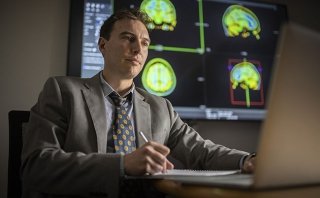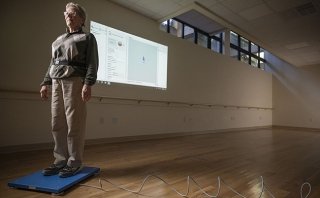Brain Stimulation Plus Coaching Helps Older Adults Double Daily Steps Versus Coaching Alone
New pilot study shows promising boost in motivation and movement for inactive older adults living in subsidized housing.
-

Assistant Scientist II
A new study published in The Journals of Gerontology: Series A reports that a novel combination of brain stimulation and personalized coaching significantly increased physical activity in older adults and held steady for months. The results offer hopeful news for inactive older adults living in subsidized housing, who may experience several barriers to increased activity, including depression and a lack of motivation
Regular physical activity is an extremely effective, safe, and modifiable means to improve health, especially in older adults. But more than 85% of adults aged 65 and above regularly fail to meet federal physical activity guidelines, and insufficient physical activity remains a global health issue.
In the randomized trial, researchers found that inactive older adults who received transcranial direct current stimulation (tDCS), a noninvasive technique that delivers low-level electrical currents to targeted areas of the brain, along with individualized behavioral coaching, increased their daily step count an average of 1,179 steps per day.
That’s more than twice the increase seen in those who received coaching and placebo stimulation. Importantly, this boost persisted for three months after the program ended, and adherence to both the stimulation and coaching was exceptionally high.
Participants in the tDCS group received 10 brief 20-minute sessions over two weeks, targeting the left dorsolateral prefrontal cortex, a region associated with motivation, planning, and goal-directed behavior. They also received a personalized behavioral program that continued for two months. The coaching, delivered by physical therapists, included regular phone check-ins, individualized step goals, and practical strategies — like marching during commercials or walking with friends — to help participants gradually increase their daily movement. Researchers tracked daily steps using Fitbits and continued monitoring participants for 12 weeks after the intervention ended.
Adherence was significant: 97% of tDCS sessions and 93% of coaching sessions were completed, with Fitbit usage remaining strong throughout the intervention. Even during the no-contact retention phase, many participants maintained increased activity, suggesting the behavioral changes had taken hold.
Beyond the physical gains, participants in the tDCS group also reported improved motivation and greater perceived walking ability. The study’s findings suggest that tDCS may enhance not just the drive to move but also the stickiness of behavior change, particularly when paired with accessible, goal-driven coaching.
While tDCS has been explored in clinical and lab settings to improve mood, memory, and motor function, this study is among the first to test its use to support real-world health behavior change in older adults, particularly those with limited resources.
“Helping older adults build and maintain healthy habits is notoriously difficult, especially in underserved communities,” said On-Yee (Amy) Lo, PhD, assistant scientist II at the Hinda and Arthur Marcus Institute for Aging Research at Hebrew SeniorLife. “This study provides early but exciting evidence that a short course of brain stimulation can ‘prime the pump’ — enhancing motivation and helping new behaviors stick — and is encouraging, especially given the setting. The program was delivered entirely within participants’ housing facilities, which removed barriers to access. That model could be a blueprint for future community-based interventions.”
The authors caution that larger trials are needed to confirm the findings and explore how tDCS might be used to amplify other types of behavioral health programs. They also note the importance of exploring how cognitive function, baseline activity level, and social support might affect outcomes.
Still, for a population at high risk for inactivity-related decline, this study offers hope — and a potential new approach — for getting and keeping older adults moving.
The researchers included Levi Ask; Melike Kahya, PT, PhD, assistant professor of physical therapy at High Point University; Thomas Travison, PhD, senior scientist at the Marcus Institute; Lewis Lipsitz, MD, director of the Marcus Institute and chief academic officer of the Irving and Edyth S. Usen and Family Chair in Medical Research, Hebrew SeniorLife; and Brad Manor, PhD, senior scientist at the Marcus Institute.
The study, Modulating Brain Activity to Improve Goal-directed Physical Activity in Older Adults: A Pilot Randomized Controlled Trial, is published in The Journals of Gerontology: Series A, Volume 80, Issue 6, June 2025, glaf039.
About Hebrew SeniorLife
Hebrew SeniorLife, an affiliate of Harvard Medical School, is a national senior services leader uniquely dedicated to rethinking, researching, and redefining the possibilities of aging. Hebrew SeniorLife cares for more than 4,500 seniors a day across campuses throughout Greater Boston. Locations include: Hebrew Rehabilitation Center-Boston and Hebrew Rehabilitation Center-NewBridge in Dedham; NewBridge on the Charles, Dedham; Orchard Cove, Canton; Simon C. Fireman Community, Randolph; Center Communities of Brookline, Brookline; Jack Satter House, Revere; and Leyland Community, Dorchester. Founded in 1903, Hebrew SeniorLife also conducts influential research into aging at the Hinda and Arthur Marcus Institute for Aging Research, which has a portfolio of more than $98 million, making it one of the largest gerontological research facilities in the U.S. in a clinical setting. It also trains more than 500 geriatric care providers each year. For more information about Hebrew SeniorLife, follow us on our blog, Facebook, Instagram, Threads, and LinkedIn.



